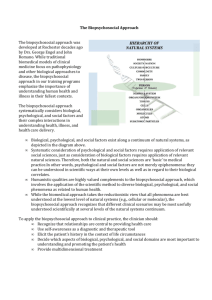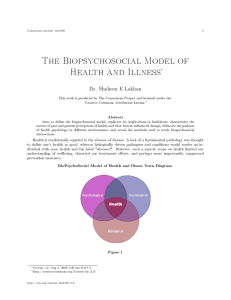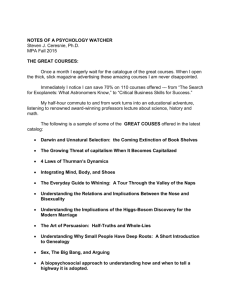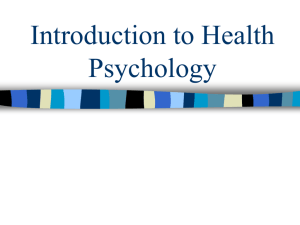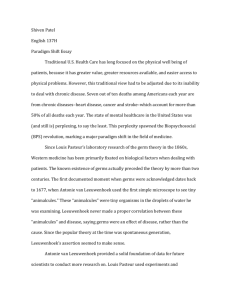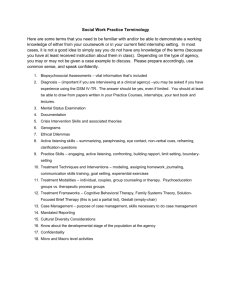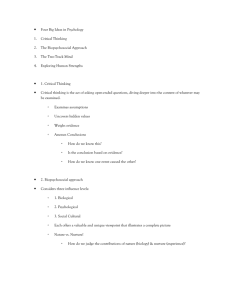Perspectives
advertisement
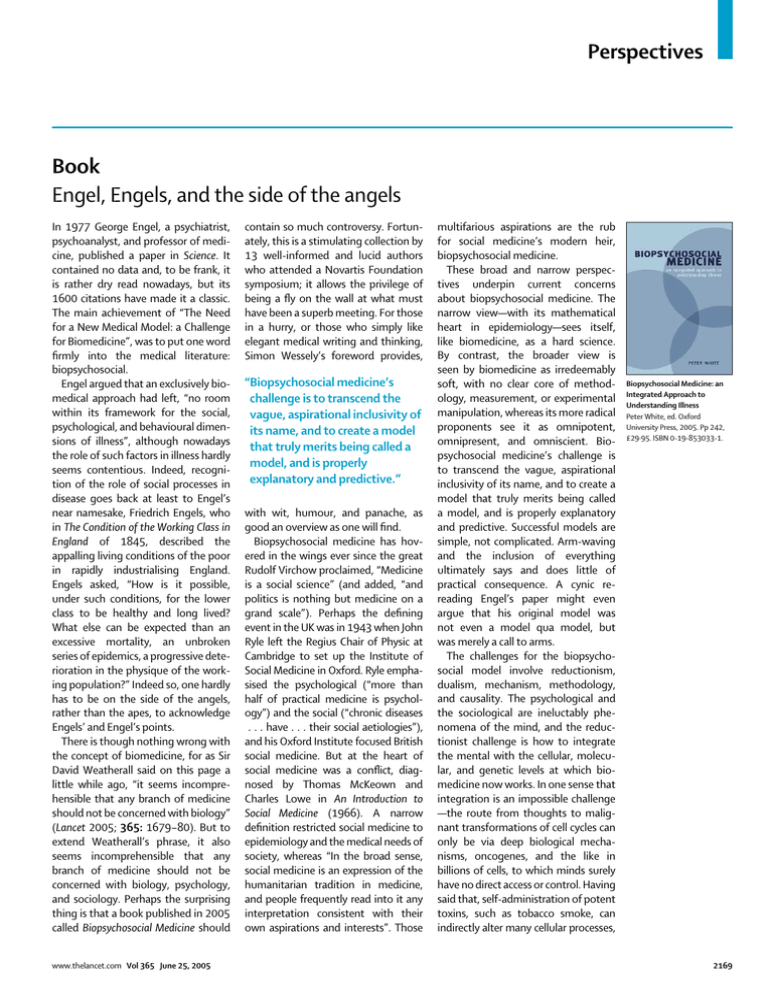
Perspectives Book Engel, Engels, and the side of the angels In 1977 George Engel, a psychiatrist, psychoanalyst, and professor of medicine, published a paper in Science. It contained no data and, to be frank, it is rather dry read nowadays, but its 1600 citations have made it a classic. The main achievement of “The Need for a New Medical Model: a Challenge for Biomedicine”, was to put one word firmly into the medical literature: biopsychosocial. Engel argued that an exclusively biomedical approach had left, “no room within its framework for the social, psychological, and behavioural dimensions of illness”, although nowadays the role of such factors in illness hardly seems contentious. Indeed, recognition of the role of social processes in disease goes back at least to Engel’s near namesake, Friedrich Engels, who in The Condition of the Working Class in England of 1845, described the appalling living conditions of the poor in rapidly industrialising England. Engels asked, “How is it possible, under such conditions, for the lower class to be healthy and long lived? What else can be expected than an excessive mortality, an unbroken series of epidemics, a progressive deterioration in the physique of the working population?” Indeed so, one hardly has to be on the side of the angels, rather than the apes, to acknowledge Engels’ and Engel’s points. There is though nothing wrong with the concept of biomedicine, for as Sir David Weatherall said on this page a little while ago, “it seems incomprehensible that any branch of medicine should not be concerned with biology” (Lancet 2005; 365: 1679–80). But to extend Weatherall’s phrase, it also seems incomprehensible that any branch of medicine should not be concerned with biology, psychology, and sociology. Perhaps the surprising thing is that a book published in 2005 called Biopsychosocial Medicine should www.thelancet.com Vol 365 June 25, 2005 contain so much controversy. Fortunately, this is a stimulating collection by 13 well-informed and lucid authors who attended a Novartis Foundation symposium; it allows the privilege of being a fly on the wall at what must have been a superb meeting. For those in a hurry, or those who simply like elegant medical writing and thinking, Simon Wessely’s foreword provides, “Biopsychosocial medicine’s challenge is to transcend the vague, aspirational inclusivity of its name, and to create a model that truly merits being called a model, and is properly explanatory and predictive.” with wit, humour, and panache, as good an overview as one will find. Biopsychosocial medicine has hovered in the wings ever since the great Rudolf Virchow proclaimed, “Medicine is a social science” (and added, “and politics is nothing but medicine on a grand scale”). Perhaps the defining event in the UK was in 1943 when John Ryle left the Regius Chair of Physic at Cambridge to set up the Institute of Social Medicine in Oxford. Ryle emphasised the psychological (“more than half of practical medicine is psychology”) and the social (“chronic diseases . . . have . . . their social aetiologies”), and his Oxford Institute focused British social medicine. But at the heart of social medicine was a conflict, diagnosed by Thomas McKeown and Charles Lowe in An Introduction to Social Medicine (1966). A narrow definition restricted social medicine to epidemiology and the medical needs of society, whereas “In the broad sense, social medicine is an expression of the humanitarian tradition in medicine, and people frequently read into it any interpretation consistent with their own aspirations and interests”. Those multifarious aspirations are the rub for social medicine’s modern heir, biopsychosocial medicine. These broad and narrow perspectives underpin current concerns about biopsychosocial medicine. The narrow view—with its mathematical heart in epidemiology—sees itself, like biomedicine, as a hard science. By contrast, the broader view is seen by biomedicine as irredeemably soft, with no clear core of methodology, measurement, or experimental manipulation, whereas its more radical proponents see it as omnipotent, omnipresent, and omniscient. Biopsychosocial medicine’s challenge is to transcend the vague, aspirational inclusivity of its name, and to create a model that truly merits being called a model, and is properly explanatory and predictive. Successful models are simple, not complicated. Arm-waving and the inclusion of everything ultimately says and does little of practical consequence. A cynic rereading Engel’s paper might even argue that his original model was not even a model qua model, but was merely a call to arms. The challenges for the biopsychosocial model involve reductionism, dualism, mechanism, methodology, and causality. The psychological and the sociological are ineluctably phenomena of the mind, and the reductionist challenge is how to integrate the mental with the cellular, molecular, and genetic levels at which biomedicine now works. In one sense that integration is an impossible challenge —the route from thoughts to malignant transformations of cell cycles can only be via deep biological mechanisms, oncogenes, and the like in billions of cells, to which minds surely have no direct access or control. Having said that, self-administration of potent toxins, such as tobacco smoke, can indirectly alter many cellular processes, Biopsychosocial Medicine: an Integrated Approach to Understanding Illness Peter White, ed. Oxford University Press, 2005. Pp 242, £29·95. ISBN 0-19-853033-1. 2169 Perspectives and the decision to self-administer can be determined by advertisements or the behaviour of peers. On the flip side, one must also realise that each picking up of a cup of coffee involves thought, and thought alone, altering subcellular organelles, as mere intentions cause the release of synaptic vesicles that activate the muscular contractions that raise the cup to the lips. Sorting out causality is difficult. Should medicine care only about proximal causes, such as the enterotoxin of Vibrio cholerae, in which case most medicine is biomedicine, or should it enquire about the causes of the cause, and the causes of the causes of the cause, for then, as John Snow recognised at the Broad Street pump, public health and poverty are integral to biopsychosocial medicine? In a provocative chapter, George Davey Smith tells a series of epidemiological cautionary tales, for which the moral is that confounding in observational studies means the only road to truth is the randomised controlled trial, and almost inexorably that excludes the psychosocial as real causes of disease. Somehow though that position ignores the nature of the confounders. Michael Marmot’s analysis of the role of social class and job status in heart disease brings the question to the fore in considering education as a risk factor. I longed here for some discussion of Ian Deary’s demonstrations of how childhood intelligence predicts adult mortality. Intelligence, despite its genetic influences, biological underpinnings, human evolutionary role, and its relation to class and social migration, is somehow still too politically incorrect for consideration. If mortality depends on intellectual choice of behaviour and lifestyles, then responsibility hangs on its tail, with a host of difficult moral and ethical issues. One symposium organiser said “The question in the title of this meeting was whether the [biopsychosocial] model is a necessity or a luxury”. Surely the angels would have to vote for the necessity of an approach, described by Peter White, the editor, as “incorporat[ing] thoughts, beliefs, feelings, behaviours, and their social context and interactions with biological processes, in order to better understand and manage illness and disability”. Lurking, though, is a feeling of two domains: “bio” for the illness and “psychosocial” for the disability. Chris McManus i.mcmanus@ucl.ac.uk In Brief Journal Global health online Globalization and Health www.globalizationandhealth.com Online journal published by BioMed Central. Editors-in-Chief Greg Martin, Derek Yach. Oxford Dictionary of Scientific Quotations W F Bynum, Roy Porter. Oxford University Press, 2005. Pp 730. £30·00. ISBN 0-19-858409-1. 2170 Two warning bells were immediately sounded as I entered the site of this new online journal. The call for papers is for “manuscripts that consider the positive and negative influence of globalization on health”. This concerns me because it suggests the editors have a rather simplistic either/or view of globalisation. Everything we have learnt to date indicates that globalisation has multiple, complex, and contradictory health impacts. A global public health response must be nuanced and admit these contradictions, otherwise we will not be in a position to seriously engage with the main driving forces of globalisation. The journal would benefit from a detailed position statement from its two main editors. My second concern relates to the composition of the associate editors, the section editors, and the editorial board; almost 40 people are listed in these categories. Two are from South Africa, the rest are residents of the USA or western Europe. The editorsin-chief need to ask themselves, as a matter of urgency, if the journal with this sort of direction will be taken seriously, especially by people from low and middle income countries. The papers themselves are a mixed bunch. A paper on international nurse recruitment and NHS vacancies, for example, offers no serious analysis of how to deal with this critical issue. A useful review of the progress since the World Summit on Sustainable Development makes the important point that “translating policies into action at all levels—global to local— remains the single biggest challenge in the years that lie ahead”. All very true of course and I guess it needs restating. The question is whether this journal is going to contribute to achieving this aim. I have my doubts. Book Eureka moments Robert Beaglehole Brian Hurwitz, Ruth Richardson beagleholer@who.int brian.hurwitz@kcl.ac.uk The literariness of scientific writing is increasingly recognised. Yet compilations of quotations generally feature scanty offerings. Bill Bynum and the late Roy Porter’s corrective plucks passages from an enormous range of literatures of science, and on science. Since good dictionaries of medical quotations already exist, entries on clinical medicine are limited. But the line between science and medicine is difficult to discern, and some clinicians do find a place, including Lister on compound fractures. The selection derives largely from famous figures, from Galen to Galton, and Hippocrates to the Huxleys. Writings on science by non-scientists are well represented, including passages from philosophers, essayists, poets, novelists, playwrights, and historians. A real plum pudding. www.thelancet.com Vol 365 June 25, 2005
